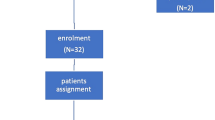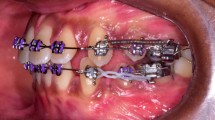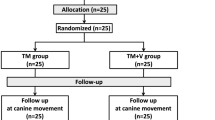Abstract
Purpose
This study aimed to determine whether orthodontic tooth movement could be accelerated by applying an intermittent force protocol. It also examined the effect of applying additional vibrational forces on orthodontic tooth movement and root resorption rates.
Methods
This study included 24 patients (16 males and 8 females) who underwent orthodontic treatment involving first premolar extraction and distal movement of the canines in the maxilla. A Hycon device (Adenta GmbH, Gilching, Germany) was used for canine distalization in all patients. The patients were randomly divided into two groups: one group received 20 min of vibration per day using the AcceleDent device (OrthoAccel Technologies, Inc., Bellaire, TX, USA), while the other group received no vibration. In addition, a split-mouth design was used: an activation-only force protocol was applied on one side, and an intermittent activation–deactivation–activation (ADA) protocol was applied on the other. The duration required for complete canine tooth distalization on each side was calculated. In addition, the effect of vibration on the orthodontically induced root resorption was examined.
Results
The intermittent ADA protocol significantly accelerated orthodontic tooth movement compared to the activation-only protocol (p < 0.05). The application of additional vibration did not affect the orthodontic tooth movement rate (p > 0.05).
Conclusions
Using a Hycon device and following an ADA protocol provided significantly faster canine distalization than the activation-only protocol (p < 0.05). This intermittent force method proved very effective in closing the spaces. However, vibration did not significantly affect the orthodontic tooth movement rate (p > 0.05).
Zusammenfassung
Zielsetzung
In dieser Studie sollte ermittelt werden, ob die kieferorthopädische Zahnbewegung durch Anwendung eines intermittierenden Kraftprotokolls beschleunigt werden kann. Außerdem wurde untersucht, wie sich die Anwendung zusätzlicher Vibrationskräfte auf die kieferorthopädische Zahnbewegung und die Wurzelresorptionsraten auswirkt.
Methoden
Die Studie umfasste 24 Patienten (16 männliche, 8 weibliche), die sich einer kieferorthopädischen Behandlung mit Extraktion der ersten Prämolaren und Distalbewegung der Eckzähne im Oberkiefer unterzogen. Bei allen Patienten wurde eine Hycon-Apparatur (Adenta GmbH, Gilching, Deutschland) zur Distalisierung der Eckzähne verwendet. Die Patienten wurden randomisiert in 2 Gruppen eingeteilt: Eine Gruppe erhielt 20 min Vibration pro Tag mit der AcceleDent-Apparatur (OrthoAccel Technologies, Inc., Bellaire/TX, USA), die andere Gruppe erhielt keine Vibration. Außerdem kam ein Split-mouth-Design zum Einsatz: Auf der einen Seite wurde ein reines Aktivierungskraftprotokoll angewendet, auf der anderen Seite ein intermittierendes ADA(Aktivierung-Deaktivierung-Aktivierung)-Protokoll. Die Dauer, die für eine vollständige Distalisierung des Eckzahns auf jeder Seite erforderlich war, wurde berechnet. Darüber hinaus wurde die Auswirkung von Vibrationen auf die kieferorthopädisch induzierte Wurzelresorption untersucht.
Ergebnisse
Das intermittierende ADA-Protokoll beschleunigte die kieferorthopädische Zahnbewegung im Vergleich zum reinen Aktivierungsprotokoll signifikant (p < 0,05). Die Anwendung von zusätzlicher Vibration hatte keinen Einfluss auf die kieferorthopädische Zahnbewegungsrate (p > 0,05).
Schlussfolgerungen
Die Behandlung mit einer Hycon-Apparatur und die Einhaltung eines ADA-Protokolls führte zu einer signifikant schnelleren Distalisierung der Eckzähne als das reine Aktivierungsprotokoll (p < 0,05). Diese intermittierende Kraftmethode erwies sich als sehr effektiv beim Schließen der Lücken. Vibration hatte allerdings keinen signifikanten Einfluss auf die kieferorthopädische Zahnbewegungsrate (p > 0,05).






Similar content being viewed by others
References
Kannan S, Fassul S, Singh AK, Arora N, Malhotra A, Saini N (2019) Effectiveness and importance of powered tooth brushes in tooth movement. J Family Med Prim Care 8(7):2478. https://doi.org/10.4103/jfmpc.jfmpc_352_19
Gkantidis N, Mistakidis I, Kouskoura T, Pandis N (2014) Effectiveness of non-conventional methods for accelerated orthodontic tooth movement: a systematic review and meta-analysis. J Dent 42(10):1300–1319. https://doi.org/10.1016/j.jdent.2014.07.013
Uribe F, Padala S, Allareddy V, Nanda R (2014) Patients’, parents’, and orthodontists’ perceptions of the need for and costs of additional procedures to reduce treatment time. Am J Orthod Dentofacial Orthop 145(4):S65–S73. https://doi.org/10.1016/j.ajodo.2013.12.015
Nishimura M, Chiba M, Ohashi T, Sato M, Shimizu Y, Igarashi K et al (2008) Periodontal tissue activation by vibration: intermittent stimulation by resonance vibration accelerates experimental tooth movement in rats. Am J Orthod Dentofacial Orthop 133(4):572–583. https://doi.org/10.1016/j.ajodo.2006.01.046
Uzuner FD, Darendeliler N (2013) Dentoalveolar surgery techniques combined with orthodontic treatment: a literature review. Eur J Dent 7(2):257. https://doi.org/10.4103/1305-7456.110201
Cruz DR, Kohara EK, Ribeiro MS, Wetter NU (2004) Effects of low-intensity laser therapy on the orthodontic movement velocity of human teeth: a preliminary study. Lasers Surg Med 35(2):117–120. https://doi.org/10.1002/lsm.20076
Davidovitch Z, Finkelson MD, Steigman S, Shanfeld JL, Montgomery PC, Korostoff E (1980) Electric currents, bone remodeling, and orthodontic tooth movement: II. Increase in rate of tooth movement and periodontal cyclic nucleotide levels by combined force and electric current. Am J Orthod Dentofacial Orthop 77(1):33–47. https://doi.org/10.1016/0002-9416(80)90222-5
Pavlin D, Anthony R, Raj V, Gakunga PT (2015) Cyclic loading (vibration) accelerates tooth movement in orthodontic patients: a double-blind, randomized controlled trial. Semin Orthod. https://doi.org/10.1053/j.sodo.2015.06.005
Miles P, Fisher E (2016) Assessment of the changes in arch perimeter and irregularity in the mandibular arch during initial alignment with the AcceleDent Aura appliance vs no appliance in adolescents: a single-blind randomized clinical trial. Am J Orthod Dentofacial Orthop 150(6):928–936. https://doi.org/10.1016/j.ajodo.2016.07.016
Woodhouse NR, DiBiase AT, Johnson N, Slipper C, Grant J, Alsaleh M et al (2015) Supplemental vibrational force during orthodontic alignment: a randomized trial. J Dent Res 94(5):682–689
DiBiase AT, Woodhouse NR, Papageorgiou SN, Johnson N, Slipper C, Grant J et al (2016) Effect of supplemental vibrational force on orthodontically induced inflammatory root resorption: a multicenter randomized clinical trial. Am J Orthod Dentofacial Orthop 150(6):918–927. https://doi.org/10.1016/j.ajodo.2016.06.025
Miles P, Fisher E, Pandis N (2018) Assessment of the rate of premolar extraction space closure in the maxillary arch with the AcceleDent Aura appliance vs no appliance in adolescents: A single-blind randomized clinical trial. Am J Orthod Dentofacial Orthop 153(1):8–14. https://doi.org/10.1016/j.ajodo.2017.08.007
Yadav S, Dobie T, Assefnia A, Kalajzic Z, Nanda R (2016) The effect of mechanical vibration on orthodontically induced root resorption. Angle Orthod 86(5):740–745. https://doi.org/10.2319/090615-599.1
Shankar D, Verma N, Mudgal P (2019) “Hycon device” A choice for orthodontic space closure: a clinical study. J Adv Med Dent Sci Res 7(8):165–168. https://doi.org/10.21276/jamdsr
Mathew R, Acharya SS, Prabhakar R, Karthikeyan M, Saravanan R, Rajvikram N (2015) Comparison of individual canine retraction using Hycon device and nickel titanium closed coil spring: In vivo study. J Indian Orthod Soc 49(3):145–151
Mclaughlin RP, Kalha AS, Schuetz W (2005) An alternative method of space closure: the Hycon device. J Clin Orthod 39(8):474
Kachiwala VA, Kalha AS, Vigneshwaran J (2007) Space closure using the Hycon device. A case report. Aust Orthod J 23(1):72
Iyano H, Himuro T, Ryu T, Fukui K, McLaughlin RP (2006) Anterior retraction using a preadjusted edgewise appliance with interrupted orthodontic force generated by a screw device. Orthod Waves 65(1):31–42
Reitan K (1957) Some factors determining the evaluation of forces in orthodontics. Am J Orthod Dentofacial Orthop 43(1):32–45
Reitan K (1964) Effects of force magnitude and direction of tooth movement on different alveolar bone types. Angle Orthod 34(4):244–255
Levander E, Malmgren O, Eliasson S (1994) Evaluation of root resorption in relation to two orthodontic treatment regimes. A clinical experimental study. Eur J Orthod 16(3):223–228. https://doi.org/10.1093/ejo/16.3.223
Rygh P (1977) Orthodontic root resorption studied by electron microscopy. Angle Orthod 47(1):1–16
Igarashi K, Miyoshi K, Shinoda H, Saeki S, Mitani H (1998) Diurnal variation in tooth movement in response to orthodontic force in rats. Am J Orthod Dentofacial Orthop 114(1):8–14. https://doi.org/10.1016/s0889-5406(98)70231-8
Karsli E, Yagci A (2018) A new system that allows modification of the pressure occurring in blood vessels at force application during orthodontic tooth movement. J Biotechnol 280:24
Leethanakul C, Suamphan S, Jitpukdeebodintra S, Thongudomporn U, Charoemratrote C (2016) Vibratory stimulation increases interleukin‑1 beta secretion during orthodontic tooth movement. Angle Orthod 86(1):74–80
Faul F, Erdfelder E, Lang AG, Buchner A (2007) G*power 3: a flexible statistical power analysis program for the social, behavioral, and biomedical sciences. Behav Res 39:175–191
Lippold C, Kirschneck C, Schreiber K, Abukiress S, Tahvildari A, Moiseenko T, Danesh G (2015) Methodological accuracy of digital and manual model analysis in orthodontics—a retrospective clinical study. Comput Biol Med 62:103–109. https://doi.org/10.1016/j.compbiomed.2015.04.012
Sharpe W, Reed B, Subtelny JD, Polson A (1987) Orthodontic relapse, apical root resorption, and crestal alveolar bone levels. Am J Orthod Dentofacial Orthop 91(3):252–258. https://doi.org/10.1016/0889-5406(87)90455-0
Woodhouse NR, DiBiase AT, Papageorgiou SN, Johnson N, Slipper C, Grant J et al (2015) Supplemental vibrational force does not reduce pain experience during initial alignment with fixed orthodontic appliances: a multicenter randomized clinical trial. Sci Rep 5(1):1–9. https://doi.org/10.1038/srep17224
Ahmed ZSH, Ahmed NSH, Ghaib NH (2015) The effect of AcceleDent® device on both gingival health condition and levels of salivary interleukin-1-βeta and tumor necrosis factors-alpha in patients under fixed orthodontic treatment. J Baghdad Coll Dent 325(3129):1–8
Lee K‑J, Park Y‑C, Yu H‑S, Choi S‑H, Yoo Y‑J (2004) Effects of continuous and interrupted orthodontic force on interleukin-1β and prostaglandin E2 production in gingival crevicular fluid. Am J Orthod Dentofacial Orthop 125(2):168–177. https://doi.org/10.1016/j.ajodo.2003.03.006
Nakao K, Goto T, Gunjigake K, Konoo T, Kobayashi S, Yamaguchi K (2007) Intermittent force induces high RANKL expression in human periodontal ligament cells. J Dent Res 86(7):623–628. https://doi.org/10.1177/154405910708600708
Taha K, Conley RS, Arany P, Warunek S, Al-Jewair T (2020) Effects of mechanical vibrations on maxillary canine retraction and perceived pain: a pilot, single-center, randomized-controlled clinical trial. Odontology. https://doi.org/10.1007/s10266-019-00480-0
Orton-Gibbs S, Kim N (2015) Clinical experience with the use of pulsatile forces to accelerate treatment. J Clin Orthod 49(9):557–573
Oz AA, Arici N, Arici S (2012) The clinical and laboratory effects of bracket type during canine distalization with sliding mechanics. Angle Orthod 82(2):326–332. https://doi.org/10.2319/032611-215.1
Kojima Y, Fukui H (2005) Numerical simulation of canine retraction by sliding mechanics. Am J Orthod Dentofacial Orthop 127(5):542–551. https://doi.org/10.1016/j.ajodo.2004.12.007
Storey E (1952) Force in orthodontics and its relation to tooth movement. Australian J Dent 56:11–18
Burstone CJ, Koenig HA (1976) Optimizing anterior and canine retraction. Am J Orthod 70(1):1–19. https://doi.org/10.1016/0002-9416(76)90257-8
Funding
This work was supported by the Erciyes University Scientific Research Projects Coordination Unit (Project code: TDH-2019-8701).
Author information
Authors and Affiliations
Corresponding author
Ethics declarations
Conflict of interest
O. Yildiz, A. Yagci and N. Hashimli declare that they have no competing interests.
Ethical standards
Approval was granted by the Ethics Committee of Erciyes University School of Medicine (Kayseri, Turkey; approval number: 2018/337). This study was registered at ClinicalTrials.gov (ID: NCT03968263). Informed consent was obtained from all individual participants included in the study. Participants aged ≥ 18 years personally signed the consent form, whereas consent was obtained from the parents of participants aged < 18 years.
Additional information
Publisher’s Note
Springer Nature remains neutral with regard to jurisdictional claims in published maps and institutional affiliations.
Rights and permissions
About this article
Cite this article
Yildiz, O., Yagci, A. & Hashimli, N. Effect of applying intermittent force with and without vibration on orthodontic tooth movement. J Orofac Orthop (2023). https://doi.org/10.1007/s00056-023-00488-w
Received:
Accepted:
Published:
DOI: https://doi.org/10.1007/s00056-023-00488-w
Keywords
- Tooth resorption rates
- Canine tooth distalization
- Duration of therapy
- Accelerated orthodontics
- Nonsurgical methods




